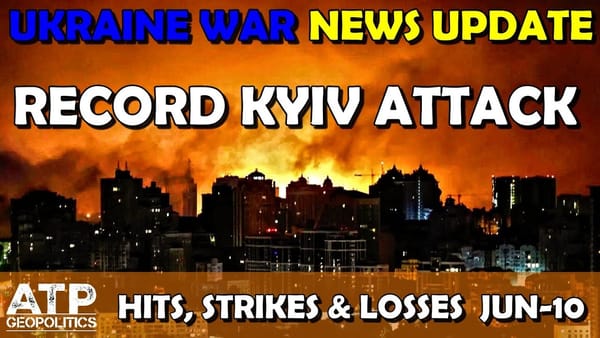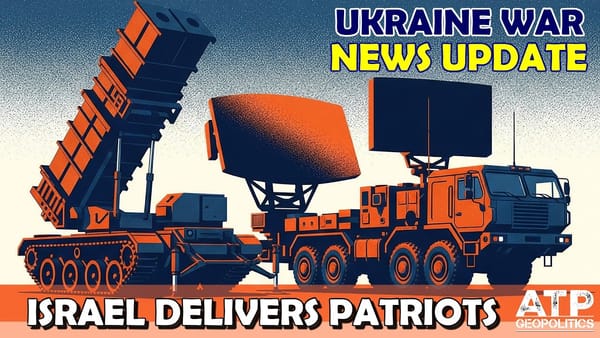Ukraine War Update NEWS: Military Aid News
Table of Contents 📖
"The US has committed more than 51 billion dollars in security aid to Ukraine since the start of the war. The weapons go to Ukraine but the vast majority of the money comes right back into the US in manufacturing facilities jobs and production"
Hello Team
🎦 00:00-02:05⏩
Jonathan welcomes viewers to part 3 of the Ukraine War Update for 30/05/2024. This episode will focus on military aid news. He thanks David L for his generous superchat during last night's live stream. Jonathan goes on to thank Davincky (who is wearing an ATP Geopolitics hoodie!). Jonathan thanks all his viewers for their support.
Return to top⤴️
Western Weapons used in Russia
🎦 02:05-06:52⏩
Jonathan discusses President Biden's potential decision to reverse the ban on US weapons being used to strike Russian territory. Jonathan believes that this should be a given, and that such discussions are unnecessary and only serve to help Putin. Jonathan believes that Ukraine should be allowed to strike back at anything that is firing at them, no matter where it is. He goes on to discuss Anthony Blinken's statement in Moldova where he said that the US would "adapt and adjust" its position on weapons strikes in Russia. Jonathan believes that this vagueness is intentional and a better strategy. He goes on to discuss Germany's position on this - that Ukraine are cautiously being allowed to use German-supplied weapons to hit Russian territory. Jonathan points out that this should come as no surprise as Denmark has already confirmed it has allowed Ukraine to use Danish weapons to strike military facilities in Russia, adding that this is “part of self-defence”. Jonathan believes that in a week's time this will no longer be a topic of discussion.
Return to top⤴️
French Military Aid and Trainers
🎦 06:52-09:56⏩
Jonathan moves on to the topic of French military aid to Ukraine. He reiterates his belief that French troops will be fighting in Ukraine (officially at least) and that it is highly likely that this will be announced imminently, perhaps during Zelenskyy's visit to Paris next week.
Return to top⤴️
F16s - Challenges/Limitations
🎦 09:56-21:10⏩
Jonathan discusses the limitations and challenges of using F16s in Ukraine. Justin Bronk (Royal United Services Institute) was interviewed on Times Radio. The key points were:
- Runways: F16s require long, smooth runways which are clear of debris, this is because the engines create a strong vacuum effect when at take-off power which could suck up debris and cause engine failure. Ukrainian airbases currently used by Sukhoi-27s and MiG-29s are more tolerant of debris and rough strips. This means that Ukraine will have to significantly upgrade some airbases. Doing so will make them a target and will be personnel-intensive - Ukraine is short of trained personnel. If they only upgrade a small number, Russia will identify them quickly.
- Starokost-Sentiniv Airbase: Jonathan believes that the reason this airbase is being targeted so frequently by Russia is because it is one of the few airbases that could accommodate F16s.
- Dispersed operating model: Ukraine has successfully used a dispersed operating model, moving aircraft around different bases, this is much harder to do with F16s.
- Ground Based Air Defences: Ukrainian ground-based air defences are already overstretched and protecting F16s from attack will be an additional challenge.
- Numbers: The number of F16s will be small (due to the issues above)
- Tactics: Ukrainian pilots are experienced but will be used to different tactics and aircraft. Jonathan questions how adaptable they will be (and willing) to adapt to Western tactics. It will take a long time to train Ukrainian pilots to reach the same level of competency as Western pilots in using F16s.
- Tankers: Ukraine cannot use tankers (aerial refuelling) because of Russia's long range air defences.
- Low Level Flying: F16s will have to fly at low level to avoid air defences and this will significantly reduce their range.
- Effectiveness: Jonathan believes that whilst the F16s will give Ukraine options, it is important to manage expectations and that they are not a “wonder weapon”. It may take a year to start seeing them being used effectively.
Jonathan concludes by saying that the F16 programme is vital to give Ukraine the capacity for internal air defence (missiles/Shahed drones) and that whilst F16s will help to some degree, they will have to be used in small numbers at first. He believes that expectations are overinflated and that it will be challenging to use them effectively straight away.
Return to top⤴️
Ukrainian ex-convicts Capture Russian Soldier
🎦 21:10-21:46⏩
Jonathan is surprised to see that Russian ex-convicts are already being used on the front lines. He had believed that this was a relatively new programme and questions whether this means that convicts have been rushed through training or if this has been in place for longer than initially thought.
Return to top⤴️
French CAESAR Howitzer Production Challenges
🎦 21:46-26:30⏩
Jonathan discusses the challenges being faced by French arms manufacturer Nexter, who produces the CAESAR howitzer, in meeting the needs of both the French military and Ukraine. The issue at hand is that the French government do not have full control of Nexter. Jonathan goes on to highlight the advantages that the US has over Europe in that it has more state ownership of its arms manufacturing facilities, giving the example that the US was able to react much faster than Europe to the upscaling of artillery shell production because of this.
Return to top⤴️
CNN Report - US Military Aid is Modernising US Military
🎦 26:30-31:10⏩
Jonathan is pleased to see a report by CNN that is finally highlighting the fact that US military spending is boosting the US economy and modernising the US military. Key points from the CNN report:
- The US is modernising its military by replacing old equipment sent to Ukraine with new equipment
- US has committed over $51 billion in security assistance to Ukraine since the start of the war.
- The vast majority of the money comes back into the US economy, creating jobs
- US Senator John Cornyn (Republican-Texas) is quoted as saying that “the US is building up the munitions stockpile that it needs to deter countries like China, Iran and North Korea”
- The US is ramping up production of Patriot missiles with the goal of producing 650 per year.
Russia's Recruitment Crisis
🎦 31:10-36:17⏩
Jonathan discusses the challenges being faced by Russia in attracting new recruits, pointing out that this is a sign that things are not going well two and a half years into the war. Russia is having to offer ever-increasing financial incentives as well as additional benefits (e.g. 40-75 days holiday) in a bid to attract recruits. He argues that potential recruits will choose better paid jobs in sectors facing labour shortages over joining the army where there is a high probability of being killed or injured. Jonathan refers to a previous video where he highlighted that Russia is having to pay higher wages to soldiers, which in turn is pushing up wages more generally, which is contributing to inflation. Jonathan goes on to discuss the illegal methods being used by Russia to bolster troop numbers. This includes forcing those who are exempt from service through illness or disability into service, and sending them to the front lines, as well as rounding up draft dodgers. Jonathan concludes that this recruitment crisis shows just how frivolous and unnecessary the war is. He does not believe that Russia can achieve its objectives without mass mobilisation and that the outlook for Russia is not good.
Return to top⤴️
Wrap up
🎦 36:17-36:20⏩
Jonathan thanks viewers for watching, asks them to like, subscribe and share.
Return to top⤴️



